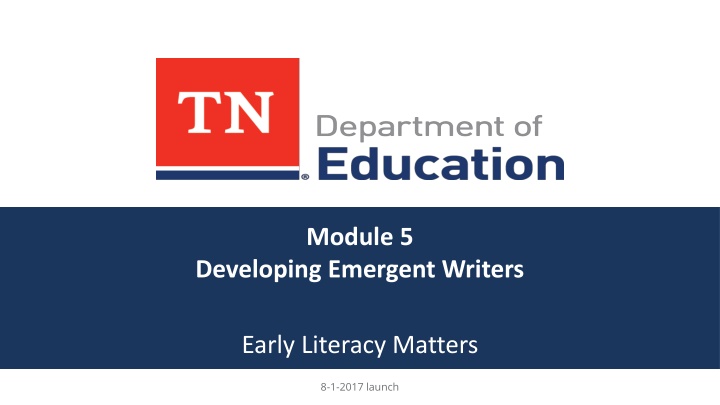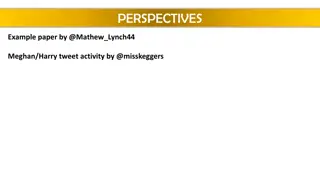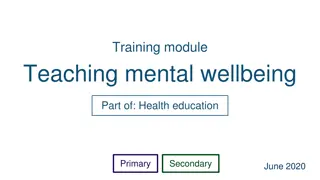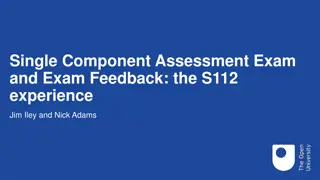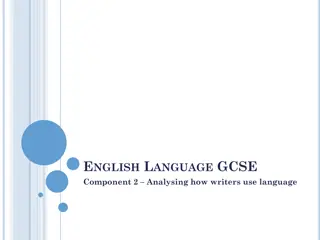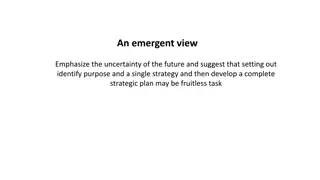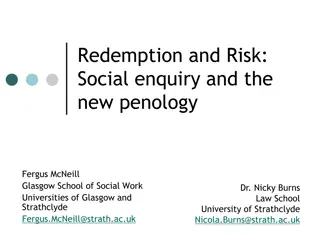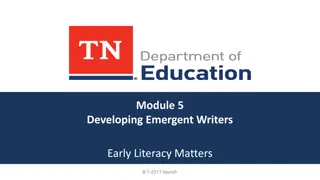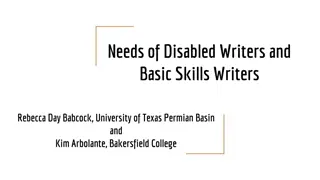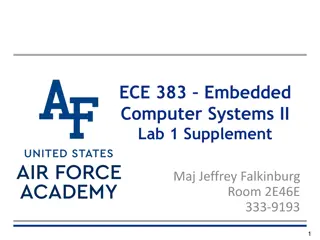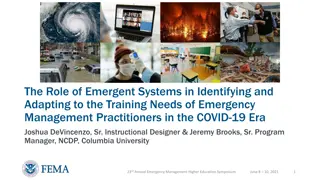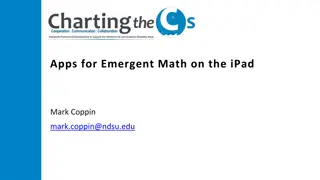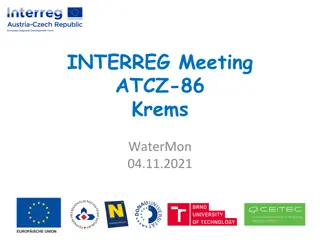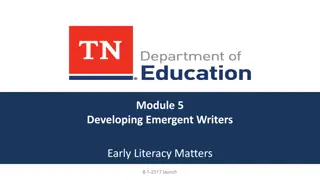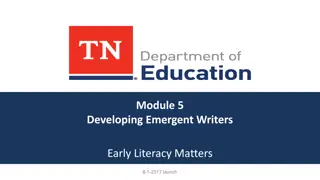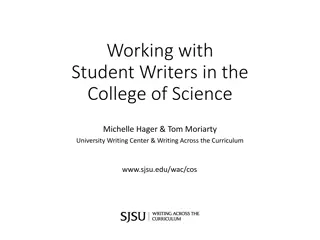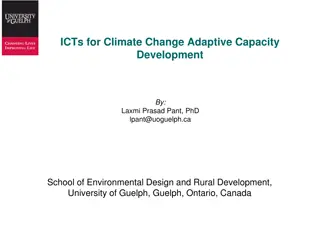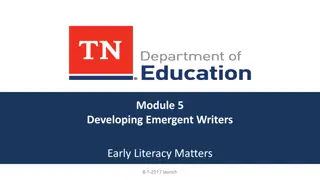Developing Emergent Writers: Module 5 Overview
Module 5 provides 3 instructional presentations focusing on preparing children for writing through fine motor activities, teacher modeling, and age-appropriate writing skill development activities. The module emphasizes the role of teachers in creating a literacy-rich environment to nurture children's interest in writing tools and materials.
Download Presentation

Please find below an Image/Link to download the presentation.
The content on the website is provided AS IS for your information and personal use only. It may not be sold, licensed, or shared on other websites without obtaining consent from the author.If you encounter any issues during the download, it is possible that the publisher has removed the file from their server.
You are allowed to download the files provided on this website for personal or commercial use, subject to the condition that they are used lawfully. All files are the property of their respective owners.
The content on the website is provided AS IS for your information and personal use only. It may not be sold, licensed, or shared on other websites without obtaining consent from the author.
E N D
Presentation Transcript
Module 5 Developing Emergent Writers Early Literacy Matters 8-1-2017 launch
Module 5: Developing Emergent Writers Module 5 at a glance In Module 4, you considered ways learning spaces and activities provide valuable opportunities for scaffolding and supporting listening, speaking, vocabulary, and phonological awareness skill development. In this module, you will: Explore specific activities for developing hand-eye coordination, finger and hand muscle strength, and left-to-right directionality needed for writing. Gain a better understanding of the important role of teachers in modeling meaningful purposes for writing. Learn how to create age-appropriate activities to develop emergent writing skills. 2
Learner Outcomes for Module 5 Learner Outcomes: LO1: Learners will describe the ways fine motor activities prepare children for writing. LO2: Learners will describe the role teachers play in modeling purposeful writing and in providing opportunities for children to experiment with writing tools. LO3: Learners will create age-appropriate activities to develop emergent writing skills for children in their classroom. 3
Connections to the Read to be Ready Campaign: This module aligns to the current Read to be Ready Campaign s following key beliefs: Early Literacy Matters: Teachers are critical: It takes a community: Video link to Early Literacy Matters from Read to be Ready Website: https://www.youtube.com/watch?v=60J8qRjRPkE 4
Module 5 Overview Overview: Module 5 will consist of 3 instructional presentations. These presentations will help you reflect on the special role a literacy-rich classroom environment plays in providing opportunities for children to develop emergent writing skills and interest in writing tools and materials. In Presentation 1, you will learn the importance of providing activities for children to develop muscles for hand-eye coordination, finger control, hand muscle strength, and left-to-right directionality. These skills physically prepare children for writing. In Presentation 2, you will focus on the important role teachers play in modeling the use of writing tools and meaningful purposes for writing. In Presentation 3, you will examine developmentally appropriate activities for developing emergent writing skills for children in the classroom. Following each presentation, you will have the opportunity to apply your learning through Application Activities included in the Learning Guide. 5
Suggested Timeline for Completing Module Modules contain 4 short presentations that are designed to be completed during relaxed ratios or other times as set by your school or agency. Your director or program coordinator may suggest or establish a timeline for each presentation to be completed within the module. Please take a moment to confirm your site s requirements while noting the submission deadline for the final Learning Application Assignment that you will submit electronically to your literacy coach for feedback and support. All other completed activities will remain in your participation guide and available for your coaches review. Section 1: Start at beginning of module and complete Presentation 1 and Practice Activity 1. Section 2: Complete Presentation 2 and Practice Activity 2. Section 3: Complete Presentation 3 and Practice Activity 3. Section 4: Complete the Learning Application Assignment for Module 5 and submit it electronically to your literacy coach for feedback and support. 6
Presentation 2: Modeling Purposeful Writing and use of Tools Teachers play an important role in modeling purposeful writing and in providing opportunities for children to experiment with writing tools. Even our youngest children develop an interest in early writing when adults model writing with purpose to create: Shopping lists Messages for mom, dad, or friends Signs with drawing and writing to label room Dictated stories told to them by children Books with pictures and writing Can you think of other examples of when adults model purposeful writing? 7
Modeling Writing Daily for Older Toddlers Think about your day working in the older toddler room. What kinds of things do you write throughout the day? Are there opportunities for older toddlers to watch and hear what you write? How might you engage older toddlers when you are writing? Can older toddlers help decorate the writing by adding stickers or color? 8
Writing Development Continuum Along with modeling purposeful writing for children, it s important for teachers to recognize how children s writing continues to develop over time. Children are eager to express themselves and communicate through writing. Their writing begins as simple marks or scribbles. It s important to celebrate these early attempts at writing and to ask children to tell you about what they wrote. Over time, scribbles become drawings, and pencil marks begin to take on letter formations. These are the early stages of writing. 9
Writing tools and materials Writing tools and materials include much more than pencil and paper such as: Clay or play dough Rubber stamps Shape stencils Lacing cards Moveable letter tiles or pieces Sand trays to write letters Sand Paper letters & numbers 10
Introducing Writing Tools & Materials Ages 2 to 5 Because we want to provide time and opportunity to develop muscle strength and hand-eye coordination, writing tools are made accessible for use for children ages 2 to 5. It s important to note that writing tools include much more than pencils and paper. Correct pencil grasp is modeled not forced since muscles and coordination is still developing and refining. Thicker pencils and crayons are easier for young children to grip. Writing tools are first used for making simple marks, scribbles, and attempts at drawing. Paper without lines allows children freely write without distraction or pressure to write within lines. They are still developing a sense of space and left-to-right orientation. Scribbles, marks, and drawings will be fill a paper. 11
Practice Activity 2: Modeling Writing Older Toddlers For this practice activity, you will talk as you write on the daily report sheet or add writing to a picture the child has created and told you about to model how talking and writing are connected. Think of how you will set the activity up for toddlers to see and hear you write about their day. Consider sitting beside the child as you talk and write. After interacting with the toddler during the Modeling Writing activity, proceed to the next part of Practice Activity 2 to reflect on the learning experience. 12
Practice Activity 2: Reflection Questions Older Toddlers Practice Activity 2: Reflect on the Modeling Writing activity you engaged in with an older toddler and briefly respond to each of the questions below in the Learning Guide: How was planning ahead helpful? How was your language intentional? How did the older toddler respond? Did your model help to reinforce the connection between talk and writing? How did your interactions help to foster the older toddler s interest in writing? 13
